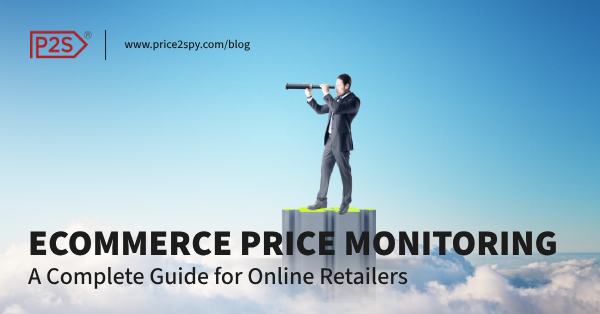
eCommerce Price Monitoring: A Complete Guide for Online Retailers
One thing is constant in eCommerce – fierce competition. Even the seemingly unique businesses will sooner or later face new competitors. In those situations, the price might be the only thing differentiating one business from another.
Winning customers based solely on price may not be a nice situation to be in. However, it can be remedied, and you can drastically increase your chances of coming out on top.
When it comes to customers, price is one of the most influential purchasing factors. Nowadays, an option that fits the customers’ budget is usually only a few clicks away.
So, how to outsmart the competition and define the right price? A part of the answer to this question lies in price monitoring.
Many eCommerce businesses are already using price monitoring excessively. But, there are also those to whom this term is still foreign.
Let’s explain what you’re missing out on if price monitoring is still not a part of your business strategy.
What is eCommerce Price Monitoring?
eCommerce price monitoring is the process of systematically tracking the prices of products sold online by your competitors. It often involves monitoring marketplaces like Amazon, Walmart, and eBay, as well as competitor websites and price comparison engines. The goal is to gather up-to-date data that helps inform your pricing strategy and protect your pricing policies, such as MAP (Minimum Advertised Price).
Unlike manual tracking, which is time-consuming and prone to errors, automated price monitoring tools like Price2Spy can check prices multiple times a day and instantly alert you to any changes. This enables you to act quickly, whether that means adjusting your prices, alerting resellers, or simply watching market trends over time.
Free 14-day trial!
Start your Price2Spy trial now, and see how it can ease the process of implementing your pricing strategy.
Try for freeWhy is Price Monitoring Important for eCommerce?
In the online marketplace, prices can change in a matter of minutes. Here’s why monitoring them is essential:
- Stay Competitive
- Keep your prices aligned with market conditions to avoid losing customers to cheaper alternatives.
- Improve Margins
- Utilize real-time data to increase prices when the competition allows it.
- Protect Brand Value
- Enforce MAP policies to maintain consistent pricing across channels.
- React Quickly
- Get alerts when competitors drop prices or go out of stock, and respond instantly.
- Understand Market Trends
- Collect historical data to spot pricing trends, seasonal fluctuations, or shifts in consumer behavior.
5 Steps to Implementing eCommerce Price Monitoring
Getting started with price monitoring doesn’t need to be complicated, but it should be thoughtful and aligned with your overall strategy. Here’s a clear, actionable process to help you implement eCommerce price monitoring effectively:

1. Define Your Objectives
Start by identifying your primary goals. Do you want to undercut competitors, protect your premium positioning, enforce MAP policies, or introduce dynamic pricing across multiple channels? Your objectives will dictate everything from the data you collect to how frequently you monitor prices. For example, a brand focused on MAP enforcement may prioritize reseller behavior, while a marketplace seller may want to react to real-time price drops.
2. Identify Key Competitors and Products
Rather than monitoring every product and every competitor, prioritize strategically. Focus on the SKUs that contribute most to your revenue or those that face intense competition. Similarly, identify your direct competitors, the ones your customers actively compare you to. You can start by analyzing marketplaces or using historical sales data to highlight which products need the most attention.
3. Choose the Right Tool
Manual tracking can’t scale with modern eCommerce. Investing in a reliable, automated price monitoring solution is critical. The right tool should allow frequent data collection, accurate product matching, and alert-based decision-making. Price2Spy, for instance, supports multi-channel monitoring, price change detection, MAP violation alerts, and even dynamic repricing capabilities. When choosing a tool, consider your technical integration needs and how easily your team can act on the insights.
4. Set Up Alerts and Reports
Once your tool is in place, configure alerts that match your business logic. For example, set thresholds to notify you if a competitor drops a price by more than 5%, or if a reseller violates MAP more than twice in a week. Pair alerts with scheduled reports daily, weekly, or monthly to monitor trends over time and ensure stakeholders stay informed. Make sure the alerts go to the right people: pricing managers, category owners, or the compliance team.
5. Analyze, Adjust, and Iterate
Data alone isn’t enough. It’s what you do with it that matters. Use insights to adjust pricing dynamically, fine-tune promotional strategies, and negotiate with resellers. Compare current performance with historical benchmarks to evaluate your decisions. Over time, review whether your initial goals are still valid, and adjust your monitoring scope or strategy accordingly. Price monitoring is not a one-time setup; it’s a continuous process that evolves with your business.
What Features Should You Look For in a Price Monitoring Tool?
Not all tools are created equal. Here are some features that can make a big difference:
- High Frequency Tracking
- Look for tools that allow several checks per day.
- Product Matching Capabilities
- Ensures you’re comparing apples to apples.
- MAP Monitoring
- Alerts you when your resellers violate pricing policies.
- Marketplace Support
- Especially for Amazon, eBay, and Google Shopping.
- Custom Alerts
- Get notified when specific thresholds are crossed.
- Data Export & API Access
- For deeper integrations and internal analysis.
- Dynamic Repricing
- Automatically adjust your prices based on competitor movements.

Dynamic Pricing: A Key Use Case
One of the most powerful applications of eCommerce price monitoring is dynamic pricing. By integrating pricing data with your store or repricing software, you can adjust prices in real time according to predefined rules. This gives you an edge in a constantly changing market, allowing you to optimize for profit, conversion rate, or even inventory turnover.
For example, if a competitor’s product goes out of stock, your system could raise your price slightly to capture more margin. Alternatively, if several competitors drop their prices, your tool can automatically match or beat their offer.
Real-World Example
Imagine you’re selling headphones on your Shopify store and Amazon. With a tool like Price2Spy, you can monitor competitor prices across both platforms, receive alerts when a competitor undercuts you, and have your system automatically adjust pricing in response. This level of automation and insight helps you stay ahead without the need for constant manual oversight.
Conclusion: Make Price Monitoring Work for You
In today’s competitive online retail environment, eCommerce price monitoring isn’t just a nice-to-have, but a necessity. From staying ahead of competitors to enforcing pricing policies, the benefits are clear. With the right tool and strategy in place, you can turn market data into a true competitive advantage.
Ready to start monitoring your prices more effectively? Try Price2Spy to gain control over your pricing strategy.




